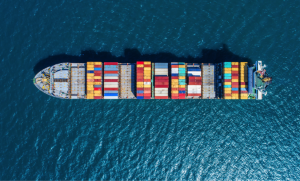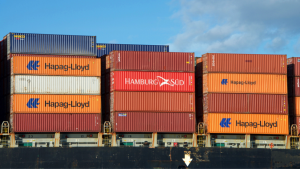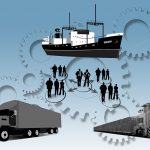How Much Cargo Can the Largest Shipping Container Ship Really Hold?
This is a Guest Post by Cory Levins, Director of Business Development for Air Sea Containers.
 It is remarkable that in an age of flight and space travel, most cargo transport around the world is still done by sea. Because of the increasing demands of global trade, cargo ships continue to acquire increasingly greater cargo capacity. Even the global economic slump has not deterred the growth of the size of these cargo vessels. The newest cargo ships are so large that it makes the question of how much cargo they can hold very interesting.
It is remarkable that in an age of flight and space travel, most cargo transport around the world is still done by sea. Because of the increasing demands of global trade, cargo ships continue to acquire increasingly greater cargo capacity. Even the global economic slump has not deterred the growth of the size of these cargo vessels. The newest cargo ships are so large that it makes the question of how much cargo they can hold very interesting.
Let us investigate the maximum capacity of these cargo or container ships, as well as how it has increased over time.
A Little Background
Humans have been transporting cargo by sea for thousands of years. Some of the first to use sea trade on a large scale were probably the Mycenaeans and the Minoans of the eastern Mediterranean. Another civilization famous for its early use of sea trade was that of the Phoenicians, who established a trade empire that stretched from the eastern coast of the Mediterranean to the coast of Morocco.
The earliest cargo vessels typically used bags and wooden crates, where the contents would have to be taken out of the containers and repackaged if they were to be transported over land by caravans or on foot. This needs to constantly unpack and repack goods as they were carried across seas and continents was very cumbersome and limited the number of goods that could be transported. This weight remained a problem for long-distance trade and cargo transport as late as the mid-20th century.
In the 1950s, the modern 20-foot-long cargo container was invented in the United States. This container was designed so it could be transferred from a ship to a train or truck without having to be unpacked. The industry then developed specialty packaging – drums, boxes and totes – to safely ship materials inside the containers.
The same container could be used for multiple modes of transport. This approach to cargo is called “intermodalism.” This made cargo transport more efficient and less labor-intensive. It also greatly increased the amount of cargo that could be transported worldwide. All that was needed to facilitate cargo transport was to increase the cargo capacity of the vessels transporting the containers. The vessels specifically built for transporting these containers came to be called container ships.
Increasing Capacity of Cargo Ships

The modern cargo container used in shipping comes in two types, the Twenty-foot Equivalent Unit (TEU) and the Forty-foot Equivalent Unit (FEU). The FEU is simply two TEU containers put together. TEU and FEU are international standards made to facilitate transport of cargo by different ships from different manufacturers.
The earliest container ships typically had a capacity of a few hundred TEU, meaning they could hold about a hundred 20-foot cargo containers. By the late 1960s, the first 1,000 TEU capacity container ships were built.
The current capacity of the largest container ships is over 20,000 TEU, and companies that build these ships intend to make them even larger. The Largest ship currently is the OOCL Hong Kong, a ship belonging to the fleet of the Hong Kong-based shipping company Orient Overseas Container Line. It has a capacity of 21,413 TEU.
Before the OOCL Hong Kong, the largest container ship in the world was the Madrid Maerskof the Danish shipping colossus Maersk, which has a capacity of 20,568 TEU. Currently, the largest ship to dock in the U.S., as of 2016, is called the Benjamin Franklin and is 398 meters long and has a capacity of 18,000 TEU. Vessels with capacities exceeding 18,000 TEU are referred to as Maersk Triple E-class vessels. These gargantuan ships have all only been built within the last decade.
It is not always easy to understand the magnitude of numbers, especially if an unfamiliar unit such as a TEU is being used. Let us see if we can put it into more understandable terms to show just how much these enormous cargo ships can contain.
The average TEU cargo container has a dimension of 20 ft. by 8 ft. by 8 ft. That is 1,360 cubic feet. That means the total volume which can be held by the OOCL Hong Kong is approximately 29,121,680 cubic feet, assuming the volume of cargo it can hold is roughly equal to the total volume of all its containers combined.
For a sense of scale, the Empire State Building has a volume of about 37,000,000 cubic feet. This volume means the cargo that can be placed into the OOCL Hong Kong and similar vessels is almost enough to fill up the entire Empire State Building. That is a lot of potential cargo!
Crew Size
These ships can fit much larger crew sizes, but the crew tends to be composed of no more than about 20-30 people. There are usually 6-14 main officers responsible for overseeing each deck, maintaining safety systems, and keeping the ship going. Besides the officers, there will be 6-14 crew members who assist them. The remarkable result is that a vessel almost as large as some of the tallest skyscrapers is manned by fewer than 50 people.
Economic and Societal Implications
These enormous container ships reflect the increasing demand for goods across the world, which demonstrates that although the economy is stagnating right now, globalization continues right on schedule. This demand is likely to increase as the Western lifestyle becomes global. As people in developing countries come to desire the same material prosperity and abundance of material goods as people living in developed countries, there will be a need to transport even more cargo worldwide.
Unless we invent much larger planes for transport or perhaps teleportation technology to transport cargo, container ships will remain in demand, and they will only get larger.
Although the demand for container ships is growing, there will be challenges to adapting to cargo ships of this size. For one thing, ports will have to be made larger to accommodate them, meaning taller cranes and deeper channels, among other modifications. One of the reasons most of these ships are deployed only in specific areas such as the Atlantic between Europe and the U.S. eastern seaboard and the Asia-Europe trade routes is that many of the ports outside these routes are too small to fit these mega-vessels.
These modifications will cost the port cities which want to benefit from these increasingly enormous container ships gracing them with their presence. Despite these possible setbacks, the industry is likely to keep growing because it has been very profitable for those involved in international trade.
Author Bio:
 Cory Levins serves as the Director of Business Development for Air Sea Containers. Cory oversees the development and implementation of ASC’s internal and external marketing program, driving revenue and profits from the Miami FL headquarters. Before joining Air Sea Containers, Cory Levins was the Director of Business Development for Marketing and Real Estate Lending Companies. Cory enjoys spending time with his family, traveling, sports, and the ocean.
Cory Levins serves as the Director of Business Development for Air Sea Containers. Cory oversees the development and implementation of ASC’s internal and external marketing program, driving revenue and profits from the Miami FL headquarters. Before joining Air Sea Containers, Cory Levins was the Director of Business Development for Marketing and Real Estate Lending Companies. Cory enjoys spending time with his family, traveling, sports, and the ocean.




When I see hese ships as long and widened going across the sea. It is a staggering sight. HOW far u have come since a small ship started on 1side of the world to the other. WHAT achievements here have been made is Mind boggling. Have a great journey the world has ever seen in the 21st Century.
Awesome Cory!!!! You should be writing full time!!